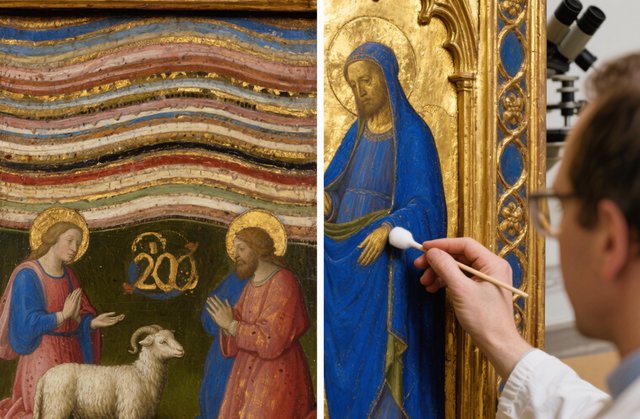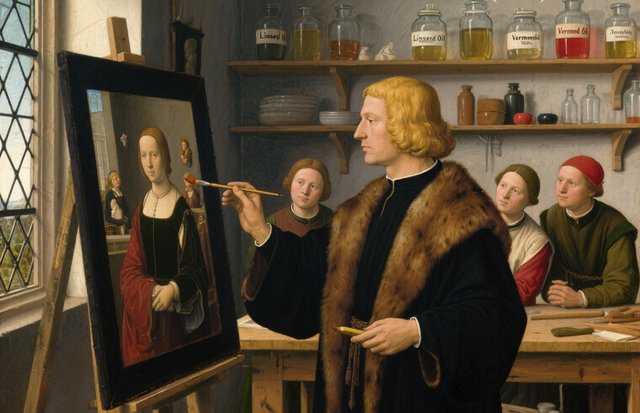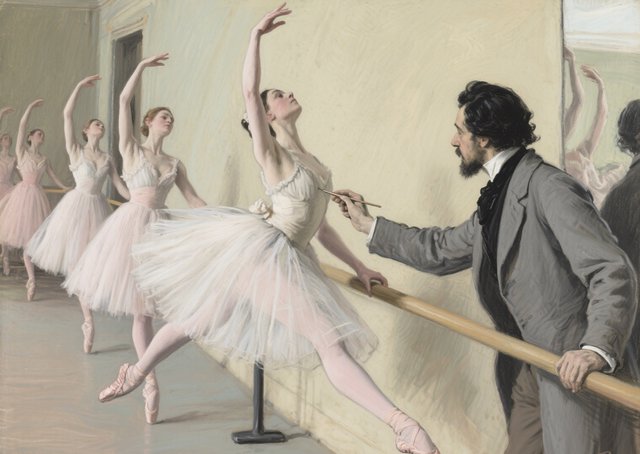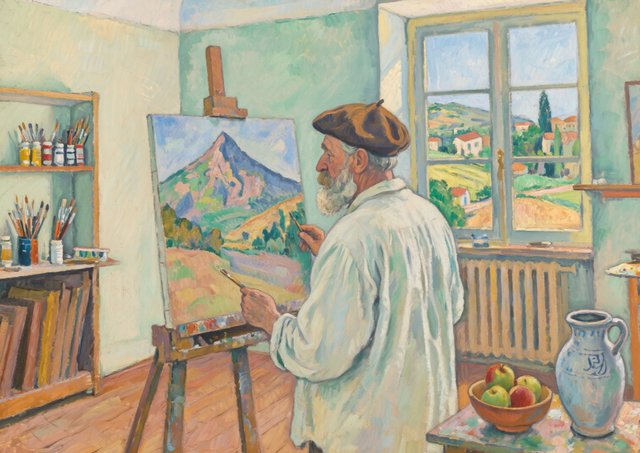Oil Painting’s 800-Year Journey: Why It’s Still Obsessed Over (Experts Spill the Secrets)

Oil painting isn’t just a medium—it’s a story spanning 800 years of human creativity. From humble beginnings in medieval workshops to the bold strokes of today’s Artists, it has outlasted trends, wars, and technological shifts. But why does this centuries-old form still make our hearts race? At theArtPaint, we’re breaking down its epic journey and the science (and emotion) behind its enduring appeal.
Part 1: The Evolution of Oil Painting—A Timeline of Innovation
1. The Medieval Spark (13th–14th Centuries)
Oil paint wasn’t “invented” overnight. Early artists in Northern Europe (modern-day Belgium and Netherlands) mixed oil with tempera (egg-based paint) to slow drying times. This let them add finer details—like the soft folds of robes in The Madonna with Child and Two Angels (c. 1290), one of the oldest surviving oil works.
These painters discovered oil’s superpower: it holds color better than tempera, which fades quickly. By the 14th century, artists like the Master of Saint Veronica were layering thin “glazes” of oil to create depth, a trick later perfected by the Flemish masters.
2. The Flemish Revolution (15th Century)
Jan van Eyck changed everything. The Flemish artist didn’t invent oil painting, but he perfected it. In works like The Arnolfini Portrait (1434), he used pure oil (no tempera) to build 20+ layers of glaze, making fabrics glow and skin look lifelike.
His secret? Linseed oil, which dries slowly, letting him blend colors for weeks. Suddenly, oil wasn’t just a tool—it was a revolution. Wealthy patrons demanded oil portraits, and the medium spread like wildfire across Europe.
3. Renaissance Glory (15th–16th Centuries)
Italy embraced oil with passion. Artists like Leonardo da Vinci and Titian combined oil’s versatility with new scientific ideas—perspective, anatomy, and light. Da Vinci’s Mona Lisa (1503–1519) uses oil to create her mysterious smile: layers of translucent glazes that shift when viewed from different angles.
Titian, meanwhile, favored bold, thick strokes (impasto) in works like Diana and Actaeon (1556–1559). Oil let him paint quickly, capturing movement—something impossible with slow-drying frescoes. The Renaissance proved oil could do it all: realism, emotion, and drama.
4. Baroque Drama (17th Century)
Baroque artists cranked up the intensity. Caravaggio used oil to create “chiaroscuro”—dramatic contrasts of light and shadow—in The Calling of St. Matthew (1599–1600). The thick, dark backgrounds (painted with oil and lamp black) make his figures pop like actors on a stage.
Rembrandt took it further. His Self-Portrait with Two Circles (c. 1665) uses oil to show age: thin glazes for wrinkles, thick impasto for stubble. He even mixed oil with ashes to create unique textures. Oil, for these artists, was a tool to tell stories of passion and power.
5. Impressionist Freedom (19th Century)
The 1800s brought a rebellion. Impressionists like Claude Monet rejected “perfect” studio paintings. They grabbed oil paints and headed outdoors, using quick, loose strokes to capture sunlight on water (Water Lilies, 1899–1926) or crowds in parks (Luncheon of the Boating Party, 1881 by Renoir).
Oil’s portability made this possible. New “tube” packaging (invented in 1841) let artists carry paints anywhere. Suddenly, oil wasn’t just for grand churches—it was for capturing everyday joy.
6. Modern Experiments (20th Century–Today)
Oil proved it could keep up with change. Pablo Picasso chopped objects into cubes in Les Demoiselles d’Avignon (1907), using oil to blend bold colors and sharp edges. Jackson Pollock dripped and splattered oil in his “action paintings,” turning the medium into a performance.
Today, artists still push boundaries: mixing oil with digital projections, or using it to paint street art. Oil’s adaptability? It’s why it outlasted acrylics and digital art as a “serious” medium.
Part 2: Why We’re Still Obsessed with Oil Paintings
1. Texture You Can Feel
No other medium has oil’s texture. Impasto strokes (think Van Gogh’s Starry Night) rise off the canvas like tiny sculptures. Glazes create depth that makes you want to reach into the painting. Even a simple still life feels “real” because oil mimics how light hits objects—shiny, matte, or somewhere in between.
Pro tip: To appreciate it, stand close to an oil painting. Notice how brushstrokes catch the light—something digital prints can never 复制.
2. Colors That Last Centuries
Oil locks in pigments like no other. A Renaissance red (made with cochineal bugs) stays vibrant today; a 19th-century blue (lapis lazuli) still takes your breath away. Acrylics fade, watercolors warp, but oil? It’s a time capsule.
This durability isn’t just practical—it’s emotional. Owning an oil painting means owning a piece of history that might outlive you.
3. It’s a Story of Skill
Oil is hard to master. It dries slowly, so mistakes spread if you’re not careful. Layering glazes takes patience; impasto requires confidence. When you see a great oil painting, you’re seeing years of practice—something our brains 本能地 admire.
Even beginners feel this. Pick up an oil brush, and you’re joining a lineage of masters. It’s why so many artists stick with it, despite the learning curve.
4. Versatility for Every Mood
Want to paint a quiet portrait? Oil does soft and subtle. A roaring landscape? It handles bold and bright. Surreal dreams? Oil blends reality and fantasy seamlessly (just ask Dalí). No other medium adapts to so many styles—and that means there’s an oil painting for everyone.
Table: Oil vs. Other Mediums—Why It Wins
| Medium | Texture | Color Longevity | Versatility | Emotional Impact |
|---|---|---|---|---|
| Oil Painting | Rich, varied | 500+ years | Adapts to all styles | High (tactile, deep) |
| Acrylic | Smooth | 50–100 years | Good for bold, fast work | Moderate |
| Watercolor | Delicate | 100–200 years | Best for light, airy scenes | Gentle |
| Digital Art | Flat | Dependent on tech | Unlimited, but artificial | Variable |
How to Connect with Oil Paintings (Even If You’re New)
Visit a museum: Stand 6 inches from a Rembrandt—you’ll see brushstrokes you never noticed in books.
Try it yourself: Buy a starter oil set (we recommend linseed oil, titanium white, and burnt sienna) and paint a fruit bowl. Feel the texture.
Learn the “why”: Research a painting’s materials. Was that blue lapis lazuli? That red cochineal? It adds layers to your appreciation.
Oil painting’s journey is our journey: a story of innovation, skill, and the human need to create something lasting. It’s not just paint on canvas—it’s 800 years of people trying to capture beauty, emotion, and truth. And that, as theArtPaint knows, is something worth obsessing over.
Ready to dive deeper? Explore our guides to mastering oil glazes, or discover 10 underrated oil masterpieces you need to see.
theArtPaint.com—where every stroke tells a story.




